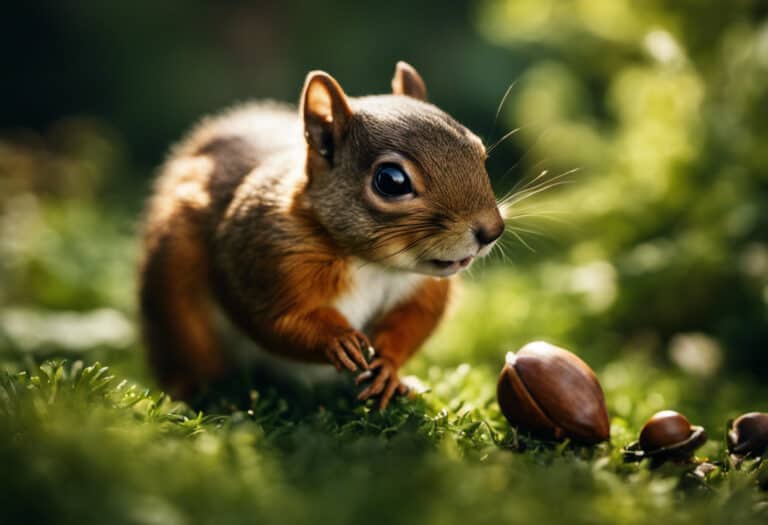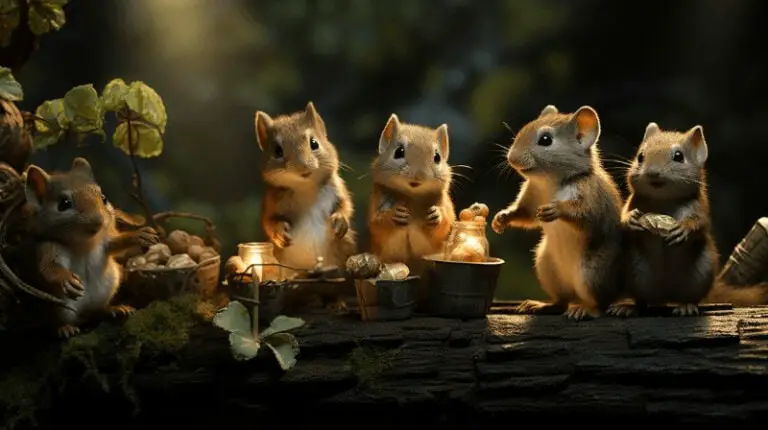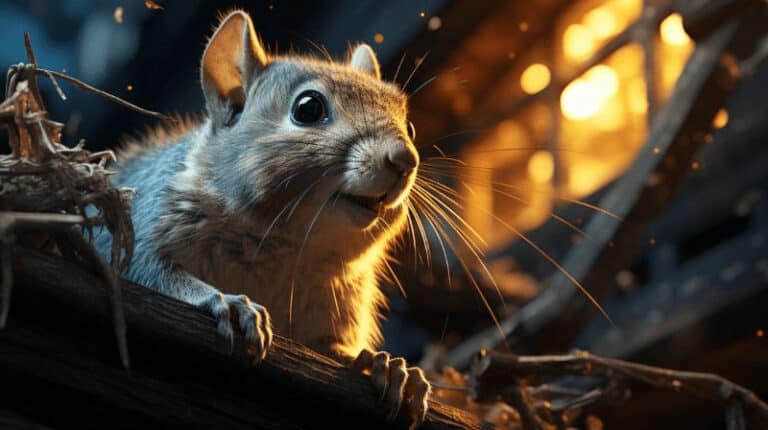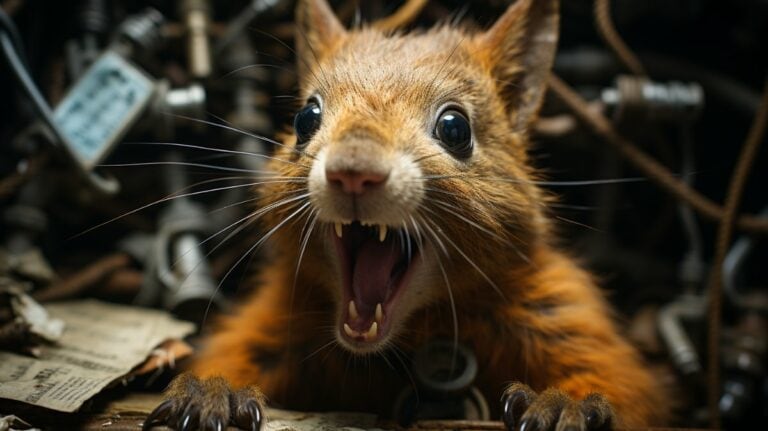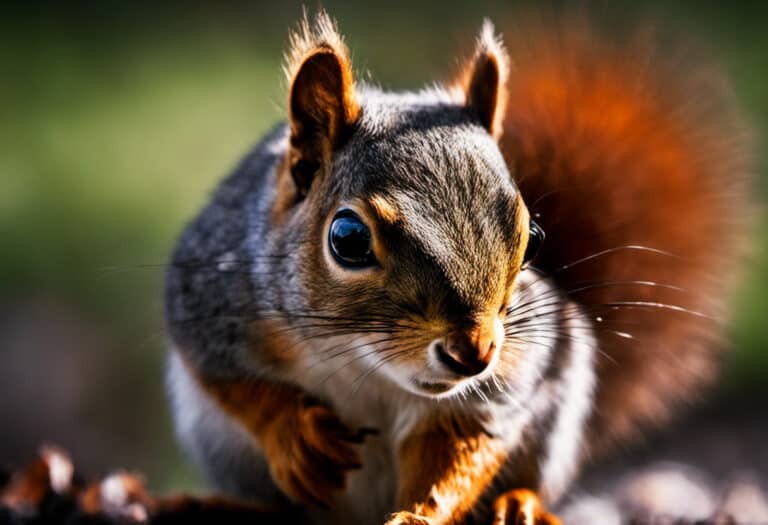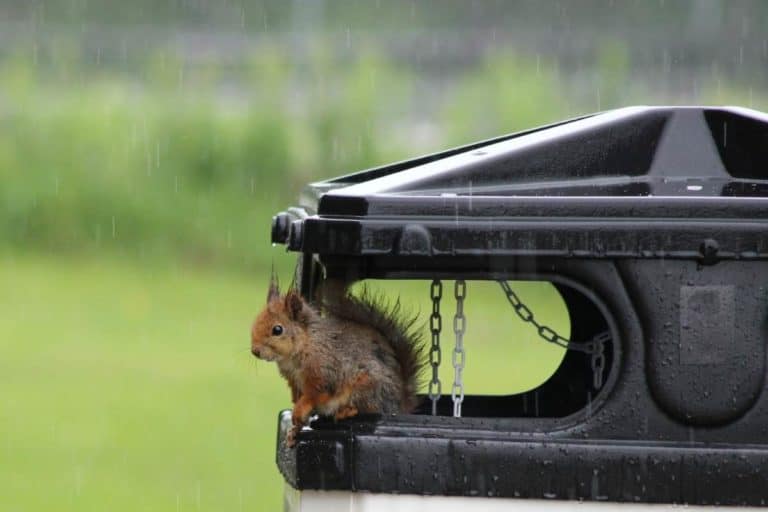Why Squirrels Flick Their Tails: Squirrels Common Behavior
Have you ever noticed a squirrel flicking its tail while it hops around in your backyard? You might have wondered what it means or whether it’s just a random behavior. Tail flicking is a common behavior among squirrels, and it serves several purposes. Understanding why squirrels flick their tails can help you appreciate these fascinating creatures and their behaviors.
Squirrels are highly active animals that are known for their quick movements and agile behaviors. They use their tails for a variety of purposes, including communication, balance, and thermoregulation.
Tail flicking is one of the most common ways that squirrels communicate with each other. By flicking their tails, they can send warning signals to other squirrels, alerting them to potential danger or predators in the area.
In this article, we’ll explore the different reasons why squirrels flick their tails and what these behaviors mean. We’ll look at how squirrels use their tails for communication, balance, and thermoregulation, as well as how they interact with predators and humans. By the end of this article, you’ll have a better understanding of these fascinating creatures and their unique behaviors.
Key Takeaways
- Squirrels use their tails for communication, balance, and thermoregulation.
- Tail flicking is a common way that squirrels communicate with each other, sending warning signals to potential danger or predators in the area.
- Understanding why squirrels flick their tails can help you appreciate these fascinating creatures and their behaviors.
Understanding Squirrel Behavior
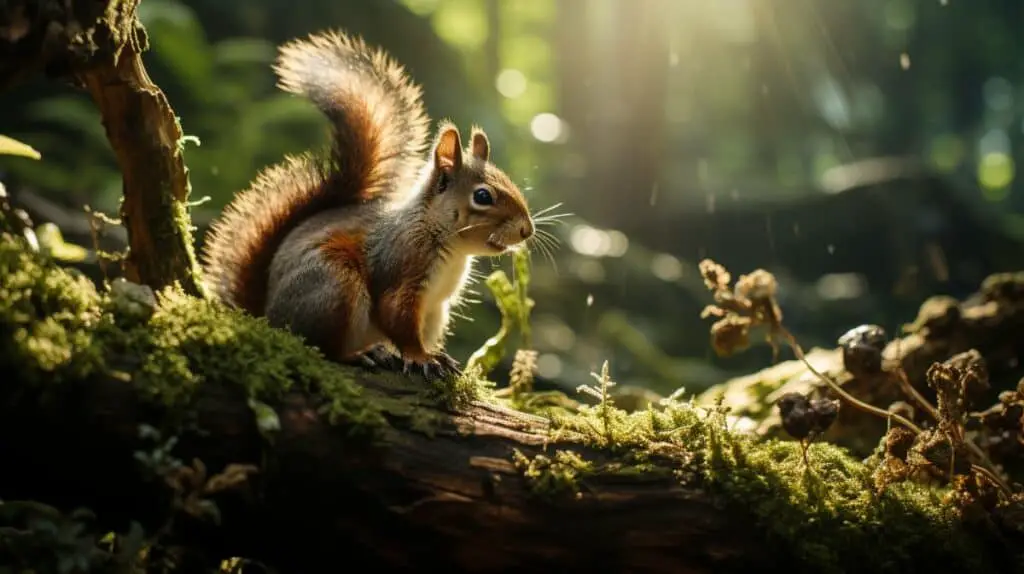
Squirrels are fascinating creatures that are known for their unique behaviors. One of the most common behaviors that squirrels exhibit is tail flicking.
Squirrels use their tails to communicate with other squirrels and to express their emotions. In this section, we will explore the different ways that squirrels use their tails to communicate and what their body language means.
Communication
Squirrels use their tails to communicate with other squirrels. They flick their tails to signal danger or to warn other squirrels of predators nearby. They also use their tails to communicate with potential mates. When a female squirrel is ready to mate, she will flick her tail to attract the attention of male squirrels.
Body Language
Squirrels also use their tails to express their emotions. When a squirrel is happy or excited, it will flick its tail rapidly. When a squirrel is scared or nervous, it will flick its tail slowly. When a squirrel is angry or aggressive, it will hold its tail up and flick it vigorously.
Other Behaviors
In addition to tail flicking, squirrels exhibit other interesting behaviors. For example, squirrels are known for their ability to store food for the winter. They will bury nuts and seeds in the ground or hide them in trees to save them for later. Squirrels are also excellent climbers and can scale trees and buildings with ease.
Related Posts:
- Where do Squirrels go when it rains? Get the Facts!
- What do Squirrels Nest Look Like?
- What Do Squirrels Eat In The Wild? (Surprising Answers)
- Where Do Squirrels Sleep? Get The Answer!
Tail Flicking as Communication
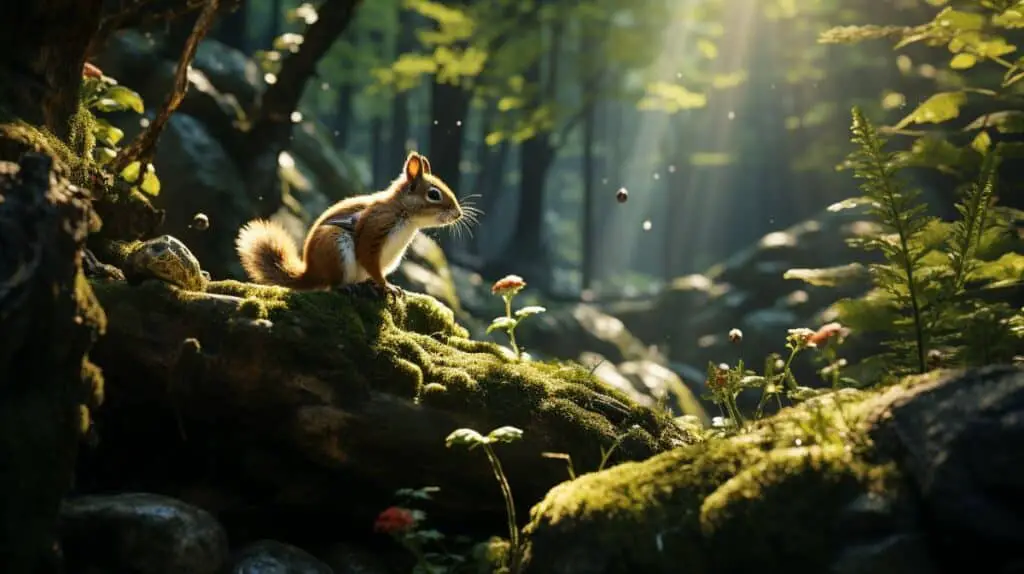
Squirrels are known for their unique behavior of flicking their tails. This behavior is not just a random movement, but it serves as a way for squirrels to communicate with each other. Tail flicking is a form of communication that can indicate different messages and signals, primarily those of warning and alarm.
One of the main reasons squirrels flick their tails is to warn other squirrels of danger. When squirrels sense danger, they will flick their tails to alert other squirrels in the area. This behavior is often accompanied by vocalizations that can also warn other squirrels of nearby predators. A study by the University of Miami found that Eastern gray squirrels use three vocal alarm calls and two types of tail signals to warn other nearby squirrels of predators.
Tail flicking can also signify mating behaviors. In some cases, squirrels may use their tails to gain attention from the opposite sex. This behavior can be seen when a male squirrel is trying to attract a female squirrel. The male squirrel will flick his tail to get the female’s attention and to show off his physical attributes.
Overall, tail flicking is an essential part of squirrel communication. It serves as a way for squirrels to warn each other of danger and to attract potential mates. Understanding this behavior can help us better understand the complex social interactions of these fascinating animals.
Related Posts:
Predator Interaction and Warning Signals
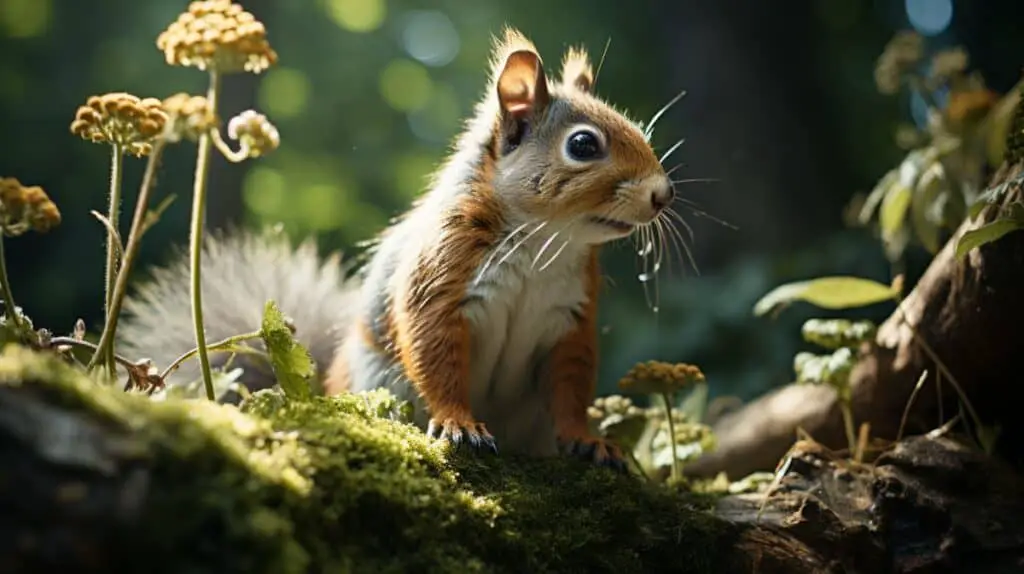
Squirrels are prey animals, and as such, they have developed a variety of ways to communicate with each other about potential danger. One of the most common ways that squirrels communicate is by flicking their tails. When a squirrel detects a predator or a threat, it will often flick its tail rapidly back and forth. This is a warning signal to other squirrels in the area that there is danger nearby.
The tail flicking behavior serves two purposes. First, it alerts other squirrels to the presence of a predator or danger. Second, it may also serve to confuse or distract the predator. By flicking its tail rapidly, the squirrel creates a lot of movement and noise, which can make it harder for the predator to focus on the squirrel itself.
Different types of predators may elicit different tail flicking behaviors. For example, when a squirrel detects a bird of prey, such as a hawk or an owl, it may flick its tail more slowly and deliberately. This may be because birds of prey are more likely to be watching for movement, and a slow, deliberate tail flick may be more effective at catching their attention.
Overall, tail flicking is an important part of a squirrel’s communication system. It allows them to quickly and effectively warn each other of potential danger, and may even help them evade predators in some cases.
Related Posts:
- Are Squirrels Afraid of Snakes? The Truth Uncovered!
- Are squirrels Dangerous? Should You Avoid Them?
Role of Tail in Balance and Agility
Squirrels are known for their impressive acrobatic skills, and their tails play a crucial role in maintaining balance and agility. The tail acts as a counterbalance, allowing squirrels to make sudden turns and changes in direction while running or jumping. It also helps them to maintain their balance while climbing trees and leaping from branch to branch.
The tail is made up of vertebrae and muscles that allow squirrels to move it in different directions. When a squirrel jumps or falls, it uses its tail to adjust its body position mid-air, ensuring a safe landing. This ability to control their tails helps squirrels to navigate through complex environments with ease.
In addition to balance and agility, the tail also plays a role in communication. Squirrels use their tails to signal danger or aggression, as well as to attract potential mates. They may flick their tails rapidly to warn other squirrels of nearby predators or shake them to show aggression towards a rival.
Overall, the tail is a crucial tool for squirrels, allowing them to navigate their environment with precision and communicate with others in their community.
Related Posts:
Mating Signals and Squirrel Courtship
Squirrels use their tails to signal their interest in the opposite sex during mating season. Male squirrels will often shake, tremble, or shiver their tails to get the attention of female squirrels. This tail motion is a way of checking if the male is safe to approach the female. If the female is interested, she will respond by flicking her tail and chattering.
Squirrels engage in a playful dance during courtship, which involves chasing each other around and jumping from tree to tree. This dance is a way of showing off their agility and strength to potential mates. Once a pair has formed, they will mate multiple times throughout the breeding season.
It’s important to note that not all squirrels mate for life. While some species are monogamous, others are not. However, both male and female squirrels will engage in courtship rituals to attract a mate during mating season.
If you’re interested in attracting squirrels to your backyard, creating a squirrel-friendly environment can help. Providing food and water sources, as well as nesting boxes and trees, can make your yard a desirable habitat for squirrels.
Related Posts:
- How to tell if a squirrel is pregnant?
- How to get a Squirrel to come to you? 20 Steps!
- How to Attract a Squirrel
- Are squirrels monogamous? The Surprising Answer
Squirrels and Human Interaction
Squirrels are commonly found in backyards and parks, and it’s not unusual to see them running along power lines. Despite their cute appearance, it’s important to remember that squirrels are wild animals and should not be treated as pets.
When it comes to human interaction, squirrels generally try to avoid contact with people. They are naturally shy and will often run away if they feel threatened. However, if you leave food out for them, they may become more comfortable around humans and even beg for food. It’s important to remember that feeding squirrels can lead to them becoming dependent on humans for food, which can be harmful to their natural behavior.
If you come across a squirrel on a power line, it’s important to keep your distance. Squirrels can easily get electrocuted if they come into contact with power lines, and they may also cause power outages if they chew through the wires. If you notice a squirrel on a power line, it’s best to contact your local power company to handle the situation.
Overall, it’s important to respect squirrels and their natural behavior. While they may seem cute and friendly, they are still wild animals and should be treated as such.
Related Posts:
Thermoregulation and Tail Flicking
Squirrels are known for their bushy tails, which they use for various purposes, including thermoregulation. A squirrel’s tail is a vital tool that helps it regulate its body temperature. When the weather is hot, the squirrel will use its tail to fan itself and cool down. On the other hand, when the weather is cold, the squirrel will use its tail to trap heat and keep warm.
Tail flicking is another behavior that squirrels use for thermoregulation. When a squirrel flicks its tail, it helps to regulate its body temperature by increasing blood flow to the tail. This increased blood flow helps to distribute heat throughout the squirrel’s body, which helps to maintain a stable body temperature.
During the winter, squirrels rely on their tails to keep them warm. Squirrels will curl up with their tails over their bodies to trap heat and keep themselves warm. They may also flick their tails to increase blood flow and generate heat.
In summary, tail flicking is an essential behavior that squirrels use for thermoregulation. They use their tails to cool down in hot weather and keep warm in cold weather. By flicking their tails, squirrels can regulate their body temperature and maintain a stable internal environment.
Related Posts:
Unique Squirrel Behaviors
Squirrels are fascinating creatures with unique behaviors that make them stand out from other animals. One of the most noticeable behaviors is tail flicking. Squirrels flick their tails for various reasons, including communication, warning, and attracting mates.
When a squirrel is startled or alarmed, it may perform a dance-like movement called the “tail-flagging” display. This display involves the squirrel rapidly flicking its tail up and down while standing on its hind legs. The tail-flagging display is believed to intimidate potential predators and warn other squirrels of danger.
Another unique behavior of squirrels is the chittering noise they make. Squirrels chitter when they are excited, scared, or angry. The chittering noise is a high-pitched sound that is often accompanied by tail flicking. Squirrels may also chitter when they see a potential mate or when they are defending their territory.
Squirrels are known for their acrobatic abilities, and they use these skills to navigate their environment. They can jump up to 10 times their body length and run up to 20 miles per hour. Squirrels also have excellent vision and can see colors, which helps them find food and avoid predators.
In conclusion, squirrels have many unique behaviors that make them fascinating animals to observe. From tail flicking to acrobatic feats, these creatures never cease to amaze us.
Related Posts:
Frequently Asked Questions
How do squirrels use their tails to communicate?
Squirrels use their tails to communicate a variety of messages to other squirrels and animals around them. For example, they may flick their tails to warn of nearby predators or to signal to other squirrels that it’s time to mate. They may also use their tails to establish dominance or to express aggression towards other squirrels.
What is the purpose of a squirrel’s tail?
A squirrel’s tail serves several purposes. It helps the squirrel to balance when climbing trees and moving along branches. It also helps to regulate the squirrel’s body temperature, as it can be used to cover the squirrel’s body when it’s cold or to fan it when it’s hot. Additionally, the tail can be used to communicate with other squirrels and animals in the area.
Do all squirrels have fluffy tails?
No, not all squirrels have fluffy tails. Some species, such as the ground squirrel, have shorter, less bushy tails. However, most tree-dwelling squirrels have long, fluffy tails that help them to navigate their environment.
What are some common squirrel body language signals?
Squirrels use a variety of body language signals to communicate with each other. For example, they may stand on their hind legs to get a better view of their surroundings, or they may flatten their ears against their heads to show fear or aggression. They may also make vocalizations such as chirps, barks, or clicks to communicate with other squirrels.
Why do baby squirrels wag their tails?
Baby squirrels may wag their tails as a way of communicating with their mother. The wagging motion can signal hunger or discomfort, and the mother squirrel may respond by providing food or comfort to her young.
What is the significance of squirrels chasing each other?
Squirrels may chase each other for a variety of reasons. Sometimes it’s just play, as young squirrels may engage in playful chasing as a way of practicing their hunting skills. Other times, it may be a territorial dispute, as squirrels may chase each other to establish dominance over a particular area.
